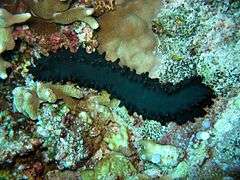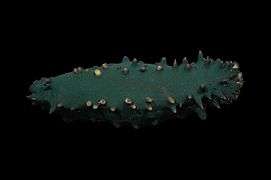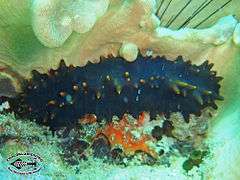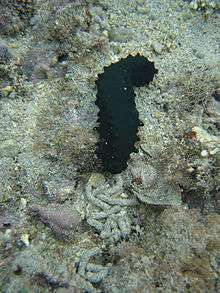Stichopus chloronotus
Stichopus chloronotus is a species of sea cucumber. Common names include the greenfish sea cucumber, the spiky sea cucumber and the black knobby sea cucumber. [3] It is native to the Indo-Pacific region. It has a wide range and is abundant and the IUCN lists it as being of "Least Concern".
| Stichopus chloronotus | |
|---|---|
 | |
| Scientific classification | |
| Kingdom: | Animalia |
| Phylum: | Echinodermata |
| Class: | Holothuroidea |
| Order: | Synallactida |
| Family: | Stichopodidae |
| Genus: | Stichopus |
| Species: | S. chloronotus |
| Binomial name | |
| Stichopus chloronotus Brandt, 1835[2] | |
| Synonyms[2] | |
| |
Description
Stichopus chloronotus is a fairly large species growing to about 25 cm (10 in) with a firm but pliable body and a squarish cross section. The skin is smooth but there are numerous conical fleshy papillae in longitudinal rows, and these are larger on the lower lateral angles. This sea cucumber is a deep blackish-green in colour, and has yellow or red tips to the papillae.[3][4]

.jpg)

 Some specimens can be blueish
Some specimens can be blueish
Distribution and habitat
Stichopus chloronotus is native to the Indo-Pacific. Its range extends from the Red Sea and the East Coast of Africa, through Madagascar, the Seychelles, the Comores and Réunion[2] to Australia, Indonesia, China, Japan, Guam, Fiji, Tonga and Samoa.[1] It lives on reefs, but can also be found on rubble located on the outer reef flats[4] at depths down to about 12 m (39 ft).[3]
Biology
Stichopus chloronotus is a detritivore and sifts through the sediment on the seabed with its tentacles and feeds on detritus and other organic matter including plant and animal remains, bacteria, protozoa, diatoms and faeces.[5] In the process it swallows a lot of sand and plays an important part in churning up and aerating the seabed.[6]
Stichopus chloronotus can reproduce asexually by undergoing transverse fission, forming two new individuals which each regenerate the missing parts. It can also reproduce sexually.[1]
Status

Stichopus chloronotus is gathered for human consumption across much of its range. Although not one of the most important species for this purpose, it resembles the much-favoured Japanese sea cucumber Apostichopus japonicus and is increasingly being caught in some areas as supplies of that species dwindle. This species has a widespread distribution and is common in many parts of its range so the IUCN lists it as being of "Least Concern".[1]
References
- Conand, C.; Gamboa, R.; Purcell, S. (2013). "Stichopus chloronotus". IUCN Red List of Threatened Species. 2013: e.T180477A1635468. doi:10.2305/IUCN.UK.2013-1.RLTS.T180477A1635468.en.
- Paulay, Gustav (2013). "Stichopus chloronotus Brandt, 1835". WoRMS. World Register of Marine Species. Retrieved 2014-02-08.
- "Greenfish sea cucumber". Florent's Guide to the Tropical Reefs. Retrieved 2014-02-08.
- "Stichopus chloronotus". North Australian Sea Cucumbers. Marine Species Identification Portal. Retrieved 2014-02-08.
- Poh-Sze Choo. "Population status, fisheries and trade of sea cucumbers in Asia" (PDF). FAO. Retrieved 2012-06-09.
- Marine Biology Papers, Volume 19 Carnegie Institution of Washington. Tortugas Laboratory, Carnegie Institution of Washington. 1924, p 34
External links
- Photos of Stichopus chloronotus on Sealife Collection
